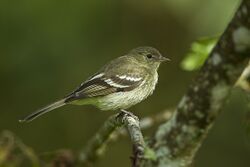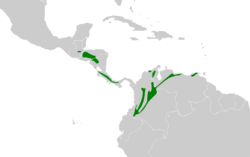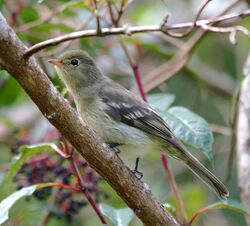Biology:Mountain elaenia
| Mountain elaenia | |
|---|---|

| |
| Scientific classification | |
| Domain: | Eukaryota |
| Kingdom: | Animalia |
| Phylum: | Chordata |
| Class: | Aves |
| Order: | Passeriformes |
| Family: | Tyrannidae |
| Genus: | Elaenia |
| Species: | E. frantzii
|
| Binomial name | |
| Elaenia frantzii Lawrence, 1865
| |
| Subspecies | |
|
See text | |

| |
The mountain elaenia (Elaenia frantzii) is a small passerine bird in the tyrant flycatcher family. It breeds in highlands from Guatemala to Colombia and western Venezuela. The scientific name celebrates the Germany physician and naturalist, Alexander von Frantzius.
Description
This tyrant flycatcher is 14–15 cm (5.5–5.9 in) long and weighs 17–20 g (0.60–0.71 oz). The upperparts are dull olive, with a narrow white eye ring. The wings are dusky with narrow yellow feather edges and two off-white wing bars. The throat and breast are yellowish grey, becoming dull yellow on the belly. Sexes are similar, but young birds are browner above, paler below and have brighter wing bars.
Subspecies
Four subspecies are recognized:[2]
- Elaenia frantzii ultima – Griscom, 1935: found in Chiapas (southern Mexico), Guatemala, El Salvador and Honduras
- Elaenia frantzii frantzii – Lawrence, 1865: found in Nicaragua, Costa Rica and western Panama
- Elaenia frantzii browni – Bangs, 1898: found in northern Colombia and northwestern Venezuela
- Elaenia frantzii pudica – Sclater, PL, 1871: found in northern and eastern Colombia, northern and western Venezuela
Behaviour
This is an inconspicuous species, with a slurred peeeeur call, longer than that of mistletoe tyrannulet, and a repetitive d’weet d’weet song. It is solitary when not breeding.
Breeding
The mountain elaenia breeds between 1,200 and 2,900 m (3,900 and 9,500 ft) in altitude in wet mountain forests, especially at the edges and in clearings and in adjacent second growth, semi-open areas, or pastures with trees. It moves lower in winter, down to 600 m (2,000 ft), and also appears to undergo seasonal movements.[3][4]
Its nest is a cup of mosses, liverworts and lichens, lined with plant fibres. It is built by the female 2–15 m (6.6–49.2 ft) high in a tree or bamboo. The two cinnamon-blotched whitish eggs are incubated by the female for 15–16 days to hatching.
Feeding
It perches on a shaded watchpoint from which it sallies forth to pick insects, spiders, and many berries and seeds from foliage or even the ground. All its food is taken in flight.
References
Notes
- ↑ BirdLife International (2016). "Elaenia frantzii". IUCN Red List of Threatened Species 2016: e.T22699298A93724789. doi:10.2305/IUCN.UK.2016-3.RLTS.T22699298A93724789.en. https://www.iucnredlist.org/species/22699298/93724789. Retrieved 12 November 2021.
- ↑ IOC v.6.3
- ↑ Hilty, Steven L. (2003). Birds of Venezuela. Princeton University Press. ISBN 0-7136-6418-5.
Sources
- Stiles, F. Gary; Skutch, Alexander F. (1989). A Guide to the Birds of Costa Rica. Comstock Publishing Associates. ISBN 0-8014-9600-4.
External links
- "Mountain elaenia media". Internet Bird Collection. http://www.hbw.com/ibc/species/mountain-elaenia-elaenia-frantzii.
- Mountain elaenia photo gallery at VIREO (Drexel University)
Wikidata ☰ Q901862 entry
 |



